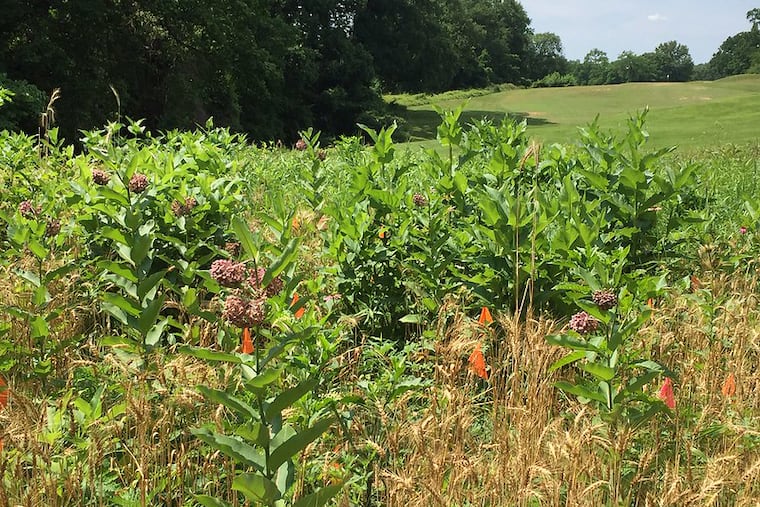Get the spades and the clippers: The weeds are trying to take over
In the heat and humidity of summer, the pace of weeds spreading is supersonic.

If you had to define the purpose of gardening, the poetic response might be that it is the act of crafting beauty from nature.
At its base, however, gardening is about holding back the immense, ravaging forces of weeds. A garden is, metaphorically, a quivering bunny rabbit surrounded by snarling wolves.
This sounds like hyperbole. It is not.
In the Mid-Atlantic, and surely in many other regions of the country, the weed pressure is unrelenting in every month of the year. In the heat and humidity of summer, the pace is supersonic.
I can leave an earthen path for a week and return to see weeds not only appear but also be established. Where bare earth stood, the bindweed sprout is a foot high, the purslane a foot across, and the galinsoga putting out its first flowers.
Vines are the worst, because they direct their energy into growing rather than building woody structures and gobbling up that greenhouse gas named carbon dioxide.
Kudzu has lodged in the public’s mind as the alien weed monster, but many others abound. The list includes English ivy, porcelain berry, bush and vining honeysuckles, ailanthus, Japanese viburnums, burning bush, and wisterias.
On the forest floor, there are unwanted carpets of Japanese knotweed, Japanese stilt grass and, increasingly, wavyleaf basketgrass.
Novices believe that you can clear your garden of weeds on a Saturday afternoon in April and be done with them for the year. But the soil is loaded with buried weed seeds, and any disturbance will lead to germination. Birds bring in seeds with their droppings. Weed seeds blow in.
One of the values of federal parkland is to remind people what can happen if they don't weed their own properties.
In time, blankets of weedy plants smother shrubs and trees and prevent the desired flora of the forest floor, such as mayapples, bluebells, ferns and trilliums, from thriving. You lose biodiversity.
Still, the weediness this summer seems worse than ever, and this may be more than just a feeling. If these invasive plants are left unchecked, their reproduction becomes exponential. There are direct parallels to the current pandemic. Unless the cycle of spread is halted early, small numbers turn into huge numbers.
“Right now, we are losing the battle,” said Jeanne Braha, executive director of Washington, D.C.‘s Rock Creek Conservancy, a nonprofit serving the nearly 2,000-acre park, which has an estimated $70 million worth of deferred infrastructure maintenance. “We don’t have the resources, time or funds to address the problem at the scale it needs to be addressed.”
If you want to be a part of the solution, Braha and Dana Dierkes, the park’s chief of interpretation, education and outreach, offer this advice: When in parks, stay on the trails and keep your dog on a leash. Wayward people and animals spread weed seeds. Don’t plant ornamentals in your garden that are known invasives and remove existing ones, including interlopers such as garlic mustard.
Mike Tidwell, executive director of the environmental group Chesapeake Climate Action Network, said one problem is that people seem to be blind to the presence of these weeds. He recently discovered that an old tulip poplar tree he admired was actually choking to death from English ivy and bittersweet.
“There was something about visiting that tree — my eyes were opened to all the invasive species killing the urban tree canopy,” he said.
Since April, Tidwell has been organizing volunteers at Takoma Park in Maryland to cut ivy from trees: “Personally, I have cut vines on 500 trees. ... If you’re a homeowner, cut vines on your property. Step two: Talk to neighbors about this.”
The Rock Creek Conservancy has produced a video on how to cut English ivy from trees. Basically, you use lopping shears or pruners to cut a stem at shoulder level and at knee level. The top growth will turn brown and eventually fall off; don’t try to rip it down, as that could damage the tree and may damage you. To be thorough, you should rip out the ivy at its roots or daub an approved herbicide on the cut stem. Just making the cuts, though, will give the tree several years of breathing room, Tidwell said. Stay away from poison ivy vines.
As part of his crusade, Tidwell has left fliers on doors where he sees ivy-covered trees and “sometimes I’ll notice a week or two later the homeowner has cut the vine and it’s turning brown. We live in ridiculously uncertain times right now. To empower yourself to save two or three trees a day is a great feeling.”